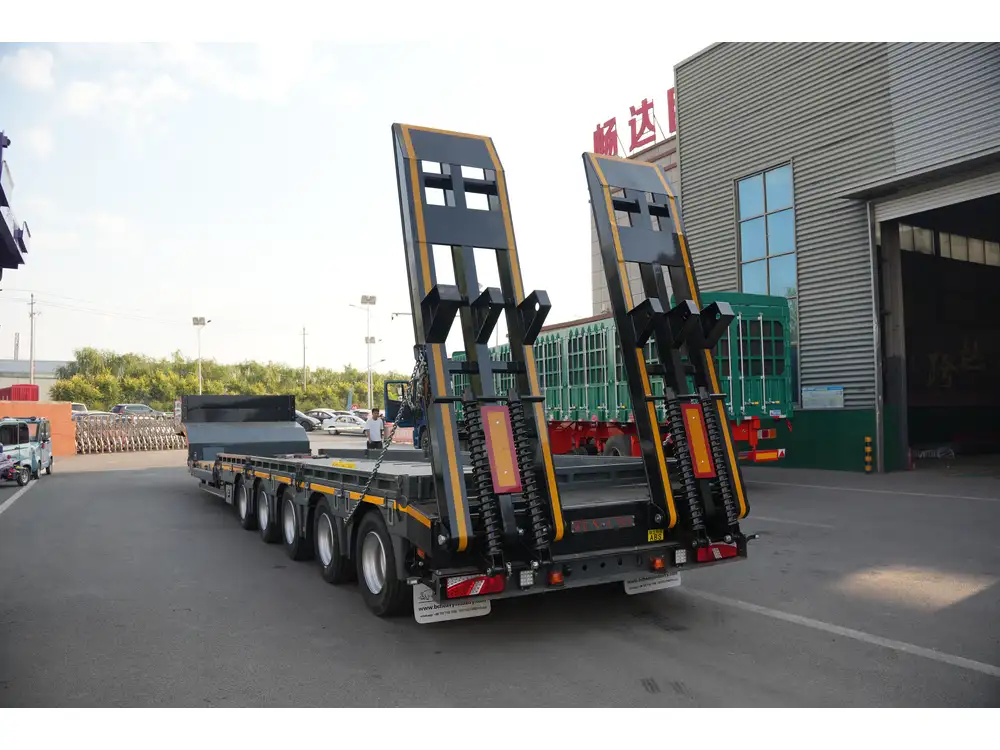Understanding Skeletal Terminal Semi Trailers
In the ever-evolving landscape of logistics and transportation, skeletal terminal semi trailers emerge as an unparalleled solution for enhanced freight management. These trailers, designed with a lightweight frame and minimalistic structure, prioritize efficiency, flexibility, and cost-effectiveness. Ideal for intermodal transport, these trailers offer the ability to easily transition between road and rail freight systems, optimizing the logistic chain from start to finish.
Key Features of Skeletal Terminal Semi Trailers
| Feature | Description |
|---|---|
| Lightweight Construction | Fabricated primarily from high-strength steel, skeletal trailers offer reduced weight without compromising sturdiness. This enables greater payloads and improved fuel efficiency. |
| Versatile Frame Design | Their unique skeletal design allows for various container sizes (20’, 40’, 45’ containers) enhancing their utility in shipping diverse cargo. |
| Enhanced Stability | Designed for road and rail transport, these trailers ensure superior stability, reducing the risk of cargo shift and damage. |
| Easy Loading and Unloading | The open-frame design facilitates quick container swaps, significantly decreasing the time spent at loading docks and enhancing turnaround times. |
| Customizable Options | Manufacturers often provide customization options, allowing clients to adapt features such as axle configurations and tare weights to suit specific operational needs. |

The Importance of Choosing the Right Skeletal Trailer
Selecting the appropriate skeletal terminal semi trailer is pivotal for logistical efficiency. The vast array of options available demands a thorough analysis of needs versus capabilities. Below, we’ll explore critical considerations to guide this important purchasing decision.
Weight Capacity and Maximum Load
Understanding the weight capacity of a skeletal semi trailer is fundamental in maximizing transport efficiency. This consideration involves:
- Assessing Cargo Needs: Calculate your typical loads, factoring in variations for seasonal demands or specific contracts.
- Compliance with Regulations: Ensure that your choice adheres to local and international weight regulations to avoid legal repercussions and fines.
Compatibility with Container Sizes
Skeletal trailers commonly support various container dimensions. Investigating compatibility is essential:
- Versatility Needs: Assess if your business frequently uses different container sizes. A trailer designed for multiple sizes can save time and money.
- Diversifying Fleet: Investing in adaptable trailers allows for fleet expansion without substantial additional costs.

Durability and Maintenance
The long-term performance and reliability of skeletal terminal semi trailers hinge on their robustness:
- Material Specifications: Investigate the durability of materials used in the construction of the frame and suspension system.
- Maintenance Requirements: Look for designs that minimize wear and tear, thus reducing the long-term operational costs associated with maintenance and repairs.
The Advantages of Utilizing Skeletal Terminal Semi Trailers
Flexibility in Operations
One of the most significant benefits offered by skeletal terminal semi trailers is their operational flexibility:
- Rapid Transitions: The ability to quickly transition from trucking to rail reduces idle time and enhances overall transport efficiency.
- Adaptability: Changing logistics needs can be swiftly addressed by the user-friendly design of these trailers.

Cost-Effectiveness
Investing in skeletal terminal semi trailers can lead to substantial cost savings over time:
- Lower Fuel Consumption: The lightweight structure of skeletal trailers means less fuel consumption, which is a key component in reducing overall operating costs.
- Reduced Labor Costs: The straightforward loading and unloading processes decrease labor time, translating into lower operational expenses.
Enhanced Safety Features
Safety is paramount in transport and logistics, and skeletal trailers are designed with this in mind:
- Stability Features: Train operators experience enhanced confidence knowing that these trailers provide better road and rail stability, reducing the likelihood of cargo damage.
- Advanced Braking Systems: Many models come equipped with sophisticated braking mechanisms that ensure safe transport even with heavy loads.
Comparative Analysis: Skeletal Terminal Semi Trailers vs. Conventional Trailers

Structural Insights
| Characteristics | Skeletal Terminal Semi Trailers | Conventional Trailers |
|---|---|---|
| Frame Design | Minimalist, lightweight, open-frame | Fully enclosed, more substantial frame |
| Load Capacity | Highly versatile, supports various container sizes | Generally fixed to specific container sizes |
| Weight | Lighter, allowing for increased payload | Heavier, which may reduce potential payload |
| Flexibility | Highly adaptable to changing loads and setups | Limited adaptability; tailored to specific use |
Cost Analysis
| Expense Category | Skeletal Terminal Semi Trailers | Conventional Trailers |
|---|---|---|
| Initial Investment | Higher upfront cost, but long-term savings | Often lower initial costs |
| Fuel Efficiency | More fuel-efficient due to lighter weight | Heavier, leading to higher fuel expenses |
| Maintenance | Lower maintenance costs | Higher due to more complicated structures |
Conclusion: Making the Right Choice
Selecting the appropriate skeletal terminal semi trailer can redefine logistics efficiencies. The unparalleled adaptability, cost-effectiveness, safety, and operational flexibility these trailers offer position them as a smart investment for logistics companies, freight forwarders, and any business involved in intermodal transport.

FAQs About Skeletal Terminal Semi Trailers
1. How do I determine the load capacity I need?
To determine your required load capacity, analyze your typical shipments over a defined period. Factor in seasonal fluctuations and peak operational times to avoid underutilization of trailer capacities.
2. What maintenance should I expect with skeletal trailers?
Maintenance typically involves periodic checks on tire condition, braking systems, and the integrity of the skeletal structure. The minimalist design significantly reduces the frequency of required maintenance compared to traditional trailers.
3. Can I modify my skeletal terminal semi trailer later?
Yes, many manufacturers provide options for modifications down the line, accommodating changes in business operations and cargo management needs.
4. What other configurations can I consider?
In addition to standard skeletal trailers, consider variations with additional axles for increased stability, adjustable height features for different loading docks, and enhanced braking technology for increased safety.
In a world where logistics need to be swift, efficient, and cost-effective, skeletal terminal semi trailers represent an apex solution. Investing in the right combination of trailers isn’t merely about transporting goods; it’s about embracing a holistic transport solution that drives long-term success and operational excellence.



